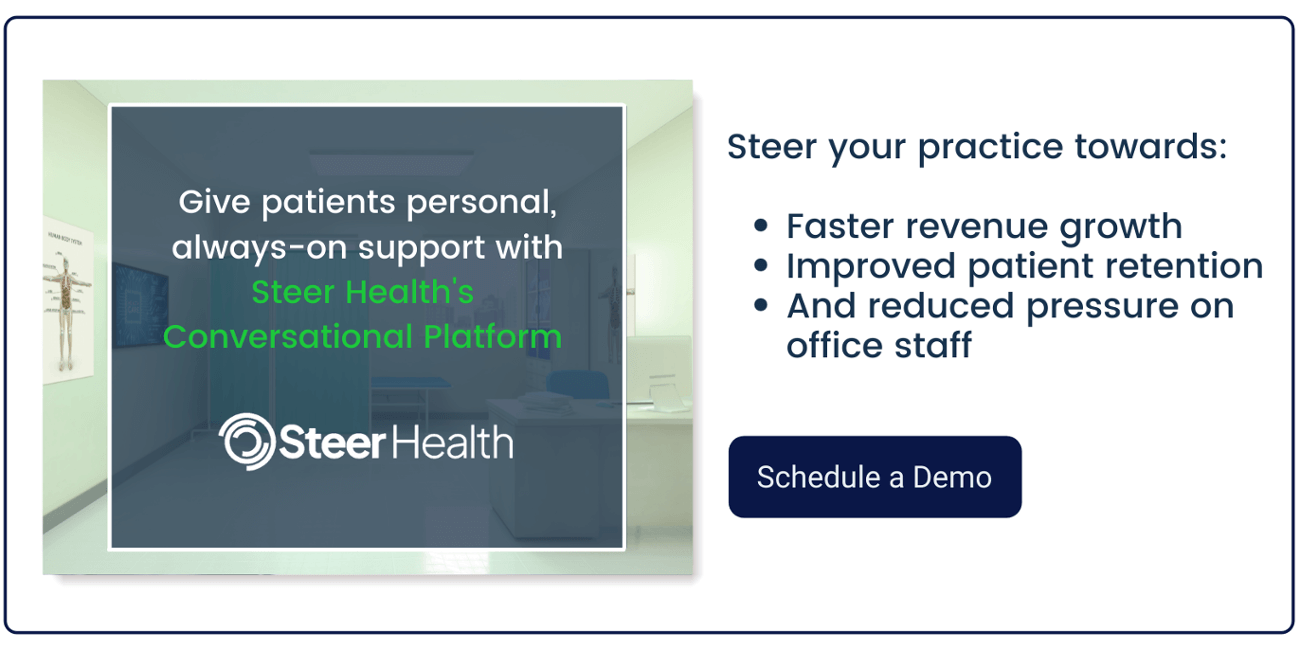Patient Experience and How to Prioritize Retention
You work hard to keep as many patients satisfied and fully treated as possible. After all, you want patients to speak highly of your practice and bring as much business in the form of referrals as possible. But what happens when you start mysteriously seeing fewer patients? And how is that directly affecting your practice’s bottom line?
Here we will walk you through the hidden costs of losing patients and why and how to keep patients continuously engaged from the moment they book their very first appointment.
What’s The “Cost” of a Single Lost Patient?
The best way to quantify the loss of patients is through a number known as "patient churn".
Patient churn is the percentage of patients who leave your care. You can measure this by calculating:
The # of customers that left your care over a time period /
The # of total customers at the beginning of that time period = Churn Rate
There tends to be considerable variations in churn percentages from one practice to the next, so the most helpful way to use your churn rate is as a benchmark. If you find this rate creeping up, you are likely losing money by not retaining enough patients or attracting new ones, which is the #1 reason for lost revenue according to the American Academy of Family Physicians:
“...missing one fee-for-service patient visit per day results in approximately $15,000 in annual losses (assuming 210 days of visits and a $72 average visit charge).
Missing one capitated patient visit per day results in a reduction of the patient panel by approximately 87 patients, which is a loss of approximately $12,500 per year (assuming 210 days of visits, an average of 2.4 visits per year per patient and a $12 per-member-per-month (PMPM) capitation rate”.
Extrapolate this to several lost patients per month, and the losses are nothing short of staggering:
“Some estimates have missed appointments costing a single physician as much as $150,000 in lost revenue and additional labor costs. That's a huge amount of money that physicians are missing out on.
For a multi-physician office, those numbers become even more staggering. One clinic had 14,000 no-shows in a single year that resulted in an estimated loss of over one million dollars.”
While you can certainly crunch the numbers and determine how many patient visits are required to break even at the end of the year -- and we certainly advocate for this -- it’s much easier to avoid patient churn in the first place.
And the best way to do this is by improving the patient experience through consistent patient engagement.

Grow Your Practice Through the Patient Experience
Engaging Patients At Every Step Of Their Journey
What exactly does it mean to “keep a patient engaged” with respect to lowering patient churn?
Health Affairs provides a succinct definition that explains the concept in simpler terms:
“Patient engagement is a broader concept that combines patient activation with interventions designed to increase activation and promote positive patient behavior, such as obtaining preventive care or exercising regularly. Patient engagement is one strategy to achieve the "triple aim" of improved health outcomes, better patient care, and lower costs.”
The reduction in costs comes from the comparative cost of acquiring new patients being far higher than retaining an existing patient.
According to the nonprofit research firm Altarum Institute:
“...patients reported a higher probability of switching providers for cost or quality reasons than physicians believed.
Furthermore, physicians reported convenience or access (moving or change in insurance coverage) as the most likely reasons for patients switching providers; patients reported more substantive reasons such as clinical efficacy and malpractice.
Overall, about half as many consumers reported complete satisfaction with their care as the number whom physicians believed were completely satisfied”.
So how can we translate the practice of increasing patient engagement into concrete, actionable steps?
Improving the Patient Experience Through Proactive Engagement
We view patient engagement as checking on each individual’s preventative needs by establishing preventive care reminders, disease or conditions specific management, and annual wellness assessments.
One of the best action steps you can take towards increasing patient engagement is by leveraging technology.
You can empower your frontline staff with modern tools such as:
- Providing detailed preventative care plan for each patient - proactive vs. reactive
- Secure 2-way text messaging
- Shared inboxes connecting chatbots made available on your practice’s website
- Patient self-service portals
- Reducing no-shows through automatic reminders of appointments and follow-up requests
These tools, in turn, will help significantly decrease wait times, one of the most commonly cited reasons for patient dissatisfaction:
“Probst et al showed that patients were more likely to be satisfied if they did not have to wait long. Camacho et al found that increased waits resulted in reduced patient satisfaction and decreased willingness to return. Dansky and Miles found that patient satisfaction decreased when the time waiting to see a clinician increased.”
Better Engagement Without Staff Burnout
The right technology allows you to take advantage of scale. Your practice can consistently engage patients better without hiring and training new members or requiring current staff members to put in more hours at the office.
Instead, you can tap into modern-day technology and nurture your employees by giving them better tools. You effectively kill two birds with one stone by optimizing patient retention AND staff retention via a first-class experience for both parties.
This naturally leads to improved morale and better bedside manner, one of the main drivers of any positive patient experience.
Prioritizing Patient Retention Through Positive Engagement
At Steer Health, we believe in fully automating the physician-patient experience by providing clinics with the infrastructure of a fully-funded hospital without the associated inefficiencies.
Our software solution reduces the time spent on tedious manual processes, lowers phone hold times, decreases lost referrals, and optimizes the patient scheduling experience.
We also help clinics manage multiple communication platforms to help patients self-serve and dictate their own experience while enhancing staff productivity with minimal training or management changes.
Steer Health helps you cultivate trust and satisfaction with your patients without requiring more effort from you or your staff.
Schedule a FREE demo with us today and see how we can help you focus on your patients and grow your business simultaneously!


